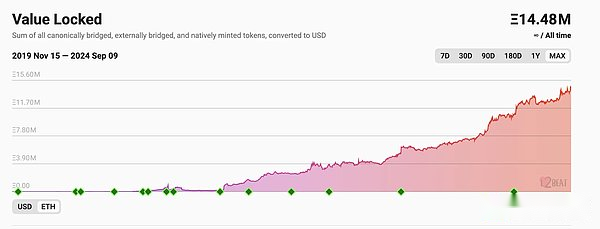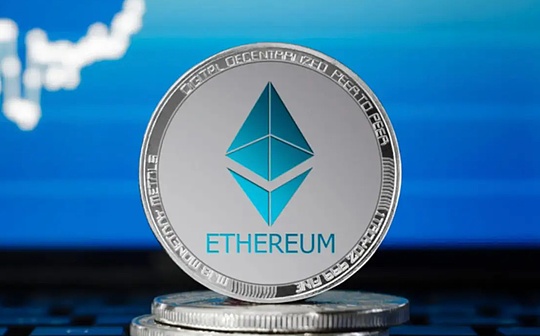
Written by: Arain, ChainCatcher
Is the price of Ethereum important?
Yes.Even Ethereum Foundation member Justin Drake’s latest issue of AMA believes that “the appreciation of ETH is crucial to the success of Ethereum.”
But in this cycle, Ethereum’s price performance was not satisfactory.According to Coingecko data, Bitcoin has risen by more than 116% against the US dollar, Ethereum has risen by 44% against the US dollar, and Solona has risen by more than 548% against the US dollar.In a blue chip portfolio, Ethereum’s price performance is obviously lagging behind.
The absence of celebrity projects, the sluggish price, and the dazzling performance of Ethereum killer “Solona” have caused Ethereum to fall into a public opinion dilemma in the past year, and doubts have emerged from time to time.This criticism against Ethereum entered a white-hot stage when the content of the Bankless dialogue Multicoin was presented.
In the show, Bankless mentioned a worrying set of data: SOL/ETH has grown at 300% annually in the past year, but the ETH/BTC ratio has fallen by 50% in the past two years, with a relatively relatively market capitalizationBitcoin has been reduced by half.
This set of data further amplifies the lag performance of Ethereum in this cycle.In this talk show, Multicoin partner Kyle Samani has described Ethereum’s situation today as a “midlife crisis.”
Interestingly, although Bankless host claimed to invite Kyle to talk about Ethereum as the best candidate at this time, Multicoin has been firmly bearish from the beginning and invested in “Ethereum Killer”.The former famous “EOS” became popular and insisted on refusing to admit its mistakes. Now, Solana, which is invested in, may have the opportunity to compete with Ethereum.
Now the question is, does the Ethereum price enters stagflation, does it really mean that there is some problem with Ethereum?As Kyle said, has Ethereum encountered a “middle-life crisis”?
Side-trading, what happened?
The description of “Ethereum does not rise” is inaccurate, especially when Ethereum compares itself.According to Coingecko data, between March 12, 2023, Ethereum’s prices were on an upward trend, although not as good as Bitcoin’s performance – once again hitting the highs of the previous cycle and setting a new high.Ethereum reached a maximum of USD 4070.6/pc during this period, while its all-time high was USD 4878.26/pc.
During this period, the market intensively released information about Bitcoin spot ETFs and Ethereum spot ETFs. The SEC finally lived up to expectations and approved Bitcoin spot ETFs and Ethereum spot ETFs on January 11, 2024 and May 24, 2024 respectively..
Perhaps affected by the news that spot ETFs were approved, the prices of Bitcoin and Ethereum began to riot in October 2023, and there is a possibility of digesting the benefits in advance.
For Ethereum, there is another difference, that is, the “Dancun (Cancun) upgrade” occurs during this period.This upgrade is a major upgrade event of Ethereum, and it is another upgrade of the main chain after Shanghai upgrade. The goal of the upgrade is to further improve performance and reduce network fees. The most intuitive manifestation is the digital asset transactions on the Ethereum Layer2 network.The required Gas expenses will be significantly reduced, with a decrease of more than 90% expected (the results are in line with expectations).
The Cancun upgrade was completed on March 13, 2024. The start and end events basically coincide with the time range of Ethereum price increase. That is to say, after the Cancun upgrade, Ethereum formed this phenomenon of “no increase”, and it still remainsThere was no sign of reversal.
After the upgrade event, Ethereum spot ETF and Ethereum spot ETP were approved by the SEC and started trading – this can also be said to be a good deal at the transaction level. Bitcoin continued to rise and set history after the Bitcoin spot ETF was approved.The high, but the script has not been staged on Ethereum.
According to Sosovalue.xyz data, since the approval, the cumulative net inflow of US Bitcoin spot ETFs has been approximately US$16.9 billion, while the cumulative net inflow of US Ethereum spot ETFs is -560 million.The listing of Ethereum ETFs did not prompt capital inflows, but instead exacerbated the loss of funds, putting pressure on Ethereum’s price.
Dune data shows that 64.7% of the U.S. Ethereum Spot ETF Asset Management Scale (AUM) is currently Grayscale, and as its corresponding buyer research Grayscale Research said in a May study this year that the U.S. Ethereum Spot ETF helpsIncrease the demand and price of ETH, but based on the high valuation when it was approved, they believe that the price increase of US Ethereum spot ETFs is less.
The price trend of Ethereum does not reflect the price support role of US Ethereum spot ETF buyers. Grayscale Research pointed out in an August research report that there are two reasons for the subsequent sharp decline in Ethereum prices:
-
On the one hand, there are long positions in perpetual futures. The approval of US spot Ethereum ETP has caused traders to increase long positions, but the longs are liquidated in the decline, accelerating the price decline;
-
On the other hand, it could be the actual and expected sell-offs of a few large holders, including market maker Jump Crypto, venture capitalists Paradigm and Golem Network, which Grayscale Research estimates that the three entities had about $1.5 billion in their hands at the time.All may be sold.
Based on the fact that Ethereum did not rebound significantly in August, Grayscale Research believes that this reflects to a certain extent the long positions of CME listed futures and perpetual futures, and the speculative positions are oversold.
“More fundamentally, the Ethereum network is undergoing a major transformation…Ethereum plans to achieve greater expansion by shifting more transactions to the L2 network, which will be periodically settled to the Layer 1 mainnet. This strategy isWorked, Ethereum L2 boomed this year, and major companies such as Sony have announced construction projects in Ethereum. However, this has also led to a reduction in the main network’s fee revenue, which further has a potential impact on the value of ETH.” Grayscale Research in SeptemberThe research report released on the 3rd stated that “Ethereum’s expansion strategy is taking effect effectively. The current market pessimism about Ethereum is unfounded, but the change in market consensus may take some time.”
In other words, there is no reversal now because the market has not reached a change in consensus on Ethereum after upgrading. One of the important points is the “reduced main network fee income”, which is the actual result of Cancun’s upgrade of EIP-4844., the expected result is to expand capacity L2 and reduce costs.The aforementioned Bankless dialogue with Multicoin program points the finger at Ethereum’s current dilemma.
So, has L2 really pushed Ethereum to the brink of danger?
Controversial L2
Multicoin’s talk show that bombarded Ethereum is mainly aimed at Layer 2. Kyle Samani proposed that “Layer 2 does not belong to Ethereum because they do not contribute to Ethereum value capture.” Specifically, Ethereum Layer 1 will all MEVsOutsourcing the execution to Layer 2 is like Ethereum giving up its money tree to others.
This view basically negates the key efforts made by Ethereum to upgrade.
Layer2 is actually a solution, not the ultimate one.Looking back at the performance of Ethereum in several historical bull markets, network congestion is often criticized. The consequence is that users often feel that the cost is very “expensive” in the bull market and even cannot be used normally. The market often calls for “ETH2.0″arrival.
ETH2.0 is a long-term plan for Ethereum upgrade. Layer2 is one of the parts, born to solve the expansion of Ethereum – it is like building an elevated road on a highway to alleviate the congestion problem on the original highway.
The Shanghai upgrade completed on April 13, 2023 opened the prelude to Layer 2. The content of the Shanghai upgrade mainly includes three aspects: changes in the EVM object format, the unstaking function of beacon chain development, and the fee reduction of Layer 2, and Ethereum POWThe mechanism is completely converted to POS.
After the upgrade in Shanghai, a large number of pledged ETHs were redeemed, and new participants were also admitted.
According to Dune data, since the Shanghai upgrade, Ethereum staking has accumulated net inflows of approximately 13.96 million ETH, reflecting market participants’ interest in Ethereum staking.However, the upgrade incident responded in the secondary market in a mediocre response. On the day the Shanghai upgrade was completed, the price of Ethereum was about US$1,920 per coin. When the Cancun upgrade was preliminarily launched (Holesky test network online), the price of Ethereum was US$1,652 per coin, which may be limited.In the market environment at that time, Bitcoin’s price performance was similar during the same period.
The Cancun upgrade completed on March 13, 2024 is the top priority of Layer 2. The most significant point is that the GAS fee is cheaper: for the same money, you can enjoy faster speeds and better after this upgrade.performance, paying less GAS fees.This has something to do with the core EIP-4844 of Cancun’s upgrade, but it’s also a point Kyle Samani slams.
Protolambda, a researcher at the Optimism team and former Ethereum Foundation researcher, once wrote that Layer1 is the data layer, L2 is responsible for performing the calculations, and Layer1 provides security for Rollup (Layer2 is one of Rollup’s solutions) and acts as a data layer.By introducing a new transaction type design that carries “blob data”, the basic layer can store Layer2 data more stress-free without affecting the security of data availability.
“blob data” is a new type of transaction introduced by EIP-4844, which is responsible for paying transaction fees. This type of large data packet has a consensus layer temporarily, which leads to a reduction in the Ethereum network and Rollup fees.

From the data, it seems that Kyle Samani’s point of view can be felt more intuitively:
Token Terminal data shows that on March 5, Ethereum L1 network revenue reached the highest (so far) day of the year, about $35 million; on September 2, the lowest one in the year, about $35 million.$200,000.The decline was 99.4% in half a year.
The Base chain, built on the Ethereum Layer2 network launched by Coinbase, generated about $2.5 million in revenue in August, but paid only about $11,000 to Ethereum.
At a glance, Layer2 took the cake from Layer1.Although judging from the existing Gas fee level, Ethereum has indeed gotten what it wants and has reduced the Gas fee on the network.But letting the “execution state” leave Layer1 and move to Layer2 is a problem at least in Kyle Samani.Bankless’s Ryan further questioned that when Layer2 develops to a certain stage, it will form a competitive relationship with Ethereum Layer1 and lead to the breakdown of cooperation.
Independent researcher @Web3Mario wrote that Layer1 and Layer2 are not what Kyle Samani calls execution outsourcing relationship, but rather a subordinate relationship, because Layer2 does not undertake the consensus task of transactions, and it relies on L1 to pass “optimistic plan” or “ZK plan” and so on.Technical means to give finality.
Layer2 plays a role as the value capture agent of Ethereum in various fields, and Ethereum uses it to ensure its security, so Layer1 “taxes” Layer2.This view seems closer to the original design intention of Ethereum Foundation researchers.
From the current data level, the Layer2 track is very inclined. After the Cancun upgrade, it has not yet contributed to Layer1’s revenue. Instead, it has divided the Layer1’s revenue. However, according to the data from l2beat., Layer2’s project has currently beenAs many as 71, and the total locked TVL surged rapidly after March 2024, with an estimated 14.48 million in ETH.

On September 5, the Ethereum Foundation research team held its 12th AMA on Reddit to answer several questions that the market is concerned about.
Among them, the foundation researcher Dankrad Feist said that Ethereum is building a most neutral financial platform, Layer1 is the intersection of multiple sub-fields, and a large number of valuable activities will be generated through fees (assuming L1’s expansion is sufficient), otherwise there are other options., for example, ETH as the main medium of exchange or the use of ETH as collateral will also be the main logic for ETH’s subsequent rise.
“Many people think that a rollup-centric roadmap will weaken Ethereum’s fee income and MEV, and eventually rollups may become parasites. I don’t think this is correct. The highest value transaction will still happen on Ethereum L1,rollups will expand the entire ecosystem by providing users with a lot of trading space. This relationship is symbiotic: Ethereum provides cheap data availability for rollups, while rollups make Ethereum L1 a natural hub for high-value transactions. “DankradFeist replied.
Ethereum Fund Researcher Anders Elowsson believes that ETH increases value when Ethereum promotes sustainable economic activity.
It is worth mentioning that expanding Layer1 is also within the scope of Ethereum’s plan, and new progress is currently available.At least from the latest remarks from official staff, it is not all about the stakes being put on the Rollup-centric roadmap, such as abandoning the expansion kit Layer1, as Kyle Samani claimed in the conversation program.
Dankrad Feist says extending Layer1 execution is the goal, in parallel with the build summary, Layer1 itself will expand to 10-1000 times the current capacity, and Rollups will provide the rest to the world scale.Ethereum Fund Researcher Justin Drake said the Ethereum Foundation’s long-term sustainability plan is to use SNARK to expand the mainnet’s EVM execution. In the past few months, the SNARKization of Layer1 EVM has made huge progress, which will enable users andThe burden on consensus participants can become lighter, and validators can verify low-cost SNARKs without having to re-execute EVM transactions.
Review of the historical crisis of Ethereum
Regardless of whether Ethereum encounters a real or fake crisis, the Ethereum team’s ability to solve problems is the most important.
Back to the crisis encountered by Ethereum several times:
1. The “Smart Contract Vulnerability Crisis” in 2016, the famous event is the “The DAO Smart Contract Vulnerability”, which caused hackers to attack and lost millions of dollars worth of Ether.
Solution: The Ethereum community decided to perform a hard fork (Ethereum Classic) to cancel transactions and restore funds.This led to the split of the Ethereum network into two versions: Ethereum and Ethereum Classic.
2. Since 2017, the Ethereum network has encountered a congestion crisis.With the rise of DApps (decentralized applications), the Ethereum network is congested and transaction fees soar.
Solution: The community began to explore solutions, which led to the prototype of ETH2.0, and introduced sharding technology and Layer 2 expansion solutions, such as Rollups and State Channels, to solve congestion problems.
3. From 2018 to the present, the high energy consumption caused by the Ethereum POW mechanism has caused concerns among environmental protection organizations and users.This is not strictly a major crisis, but the impact of the solutions it has contributed to the Ethereum network is important and therefore listed.
Solution: Ethereum seeks to transform from Proof of Work (PoW) to Proof of Stake (PoS) to reduce energy consumption.
Ethereum, which is facing a crisis, has given some historical development opportunities for new public chains called “Ethereum Killers”. BNB Chain, Cardano, Avalanche, Polkadot, EOS, Solana, etc. Except Solana is in progress, the rest are more or more.Shao once competed with Ethereum in terms of momentum.
After Layer 2, Solana is still calling out on the road of “Ethereum Killer”, and one of the biggest investors and supporters behind it is Multicoin.
In this sense, Ethereum is successful.







